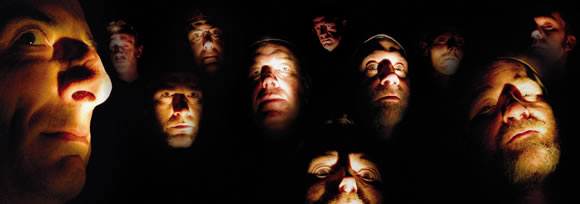Here’s a recording of part of a news report in a mystery language.
Do you know or can you guess which language it is and where it’s spoken?
Here’s a recording of part of a news report in a mystery language.
Do you know or can you guess which language it is and where it’s spoken?

Noght ta mee goll dys cuirrey-kiaull ‘syn Galeri Caernarfon lesh ny Fir Scaanagh (Spooky Men), sheshaght chiaullee voish Yn Austrail ta jannoo turrys mygeayrt yn Reeriaght Unnaneyssit ec y traa t’ayn. She arraneyderyn yindyssagh ad, as t’ad goaill arraneyn feer aitt – ta mee jeeaghyn roym lesh.
Heno dw i’n mynd i gyngerdd yn y Galeri Caernarfon gan y Dynion Bwganod (Spooky Men), côr o Awstralia sy’n teithio o gwmpas y DU ar hyn o bryd. Maen nhw’n canu yn ardderchog, ac yn canu caneuon doniol iawn – dw i’n edrych ymlaen ato yn fawr.
Anocht tá mé ag dhul chuig ceolchoirm sa Galeri Caernarfon lena Fir Uaigneach (Spooky Men), cór ón Astráil atá ag tabhairt camchuairt na Ríochta Aontaithe ar faoi láthair. Is amhránaithe den scoth iad, agus bíonn siad ag canadh amhráin an ghrianmhar – tá mé ag súil go mór leis.
Recently while reading Douglas Coupland novel Gum Thief I came across a used of bus(ing) that I hadn’t heard before – one of the characters talks about “busing” tables, which sounded a bit strange to me. I’m familiar with the word busboy, but haven’t been quite sure what a busboy did. Now I’ve discovered that a busboy, busgirl or busser is someone who works in a restaurant clearing and laying (busing) tables and helping the waiting staff – a kind of assistant waiter. I’ve never heard this expression being used in the UK though and, as far as I know, no equivalent position exists here – waiters and waiteresses are normally responsible for clearing and laying tables.
The use of busing to refer to clearing tables was apparently first attested to 1913 and probably comes from the four-wheeled cart used to carry dishes.
In the UK the word busing might be used in the context of transporting people by bus, especially school children. According to Wikipedia busing is “The transportation of schoolchildren, by bus, to schools in other neighbourhoods in order to alleviate social inequalities or to achieve racial integration.”
Are busing or to bus used in other English-speaking countries? If so, what does in mean?

T’eh ceau fliaghey dy mennick er y gherrid, as t’eh deayrtyey ny keayrtyn. T’ad gra dy vel laghyn fliaghagh graynoil, as ta niart mooinjer gra nagh row sourey ain mleeaney, agh er lhiam dy vel y fliaghey mie dy liooar myr ta eaddaghyn kiart ayd, as myr ta ymmyrkey jarrooagh ayd.
Mae’n bwrw glaw yn aml yn ddiwedar, ac weithiau mae’n bwrw yn drwm iawn. Maen nhw’n dweud bod diwrnodau glawog yn ofnadwy, ac mae llawer o bobol yn dweud nag oedd gynnon ni haf eleni, ond dw i’n meddwl bod y glaw yn iawn os oes gen ti dillad addas, ac os oes gen ti agwedd positiv.
Dw i’n ceisio ysgrifennu tipyn bach yn Fanaweg bob dydd ac yn dechrau heddiw. Bydda i’n cyfieithu i’r ieithoedd Celtaidd eraill os oes gen i digon o amser.
Yesterday I finally finished the British Sign Language (BSL) course I’ve been working on for the past year – if other things didn’t keep distracting me I would have finished it sooner. The course consists of just seven unit but manages to fit quite a lot in them, including numbers, colours, time, money, describing people, tenses, hobbies and interests, and food and drink. It also shows you how to construct sentences, and provides background information about sign language and the deaf community. I’ve found it fascinating and would like to learn more. Unfortunately there aren’t any sign language courses available in this area, but I do have a few books on BSL and a CD-ROM.
BSL is a bit simliar to Chinese languages in terms of structure – eg it’s an isolating language which uses time expressions to indicate when things happen rather than conjugating verbs. So you sign things like “Yesterday I eat cake” or “This morning I go to work”. Unlike Chinese or other spoken languages, sign languages can modify signs (words) to add nuances to their meanings. The amount of movement in a sign might be increased and/or its direction changed: for example instead of signing the equivalent of “she’s jumping high” you could sign “she’s jumping” with the sign for jump going higher than usual. Or if you’re describing someone’s hair you can modify the sign for hair to indicate whether it’s straight, curly, long or short hair.
One thing I plan to do with BSL is to link signs to words in the languages I’m learning. This will give me something extra to help me remember the words, and will help me to link words in different languages without using English. I think the physical nature of signs helps me remember them better than spoken words – my auditory memory is good, but my physical memory seems even better.
Have you studied or are you studying a sign language?